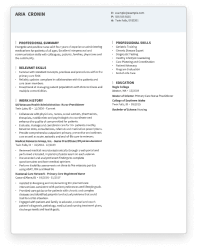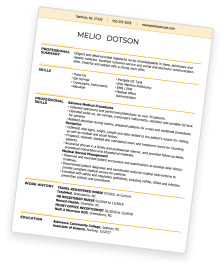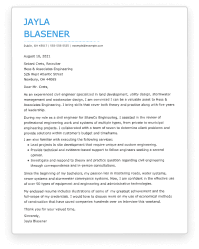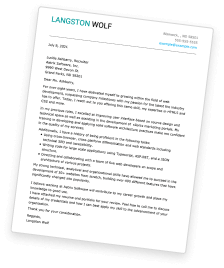Orthodontist Resume: Overview
As an orthodontist, you stand at the crossroads of health and aesthetics, providing essential treatments that not only improve oral function but also enhance self-confidence through the gift of a better smile.
Your role encompasses diagnosing and treating dental malocclusions and jaw irregularities, designing custom treatment plans, and applying fixtures such as braces and retainers.
Your practice might be situated in diverse settings, including:
- Private Orthodontic Practices
- Dental Groups or Partnerships
- Hospitals and Dental Clinics
- Academic and Research Institutions
- Teleorthodontics Platforms
Crafting an exceptional resume is crucial for showcasing your specialized skills, from clinical competencies to patient communication and technological proficiencies.
Whether you’re just launching your career or seeking new opportunities to expand your practice, our expertly designed resume templates and professional examples are here to guide you through highlighting your professional achievements and contributions to orthodontics.
Orthodontist Resume: Choose A Format
Selecting the right format for your orthodontist resume is the first critical step in crafting a document that not only reflects your career achievements but also aligns with your professional growth ambitions.
The resume format you choose should effectively highlight your qualifications, making your application stand out in a competitive field.
There are three primary resume formats that orthodontists can consider:
Chronological Resumes for Orthodontists
The chronological resume format is highly favored and generally recommended for orthodontists, particularly because it emphasizes your professional experience.
This format is ideal for showcasing your career progression, including positions held, practices where you’ve worked, and the specific treatments and procedures you’ve mastered.
For each position listed in the work history section, provide a detailed account of your responsibilities and accomplishments, including the job title, employer’s name, location, and the dates of employment.
Highlight your achievements with bullet points that use strong action verbs and, where possible, quantify your contributions to patient care, practice growth, or technological innovation.
Chronological resumes are also advantageous because they are well-suited for Applicant Tracking Systems (ATS), making them a wise choice for ensuring your resume is noticed during preliminary screenings.
Functional Resumes for Orthodontists
Functional resumes focus on the skills and expertise of the applicant, rather than their employment history.
This format can be particularly useful for new graduates, orthodontists re-entering the workforce, or those who have significant gaps in their employment.
For instance, a recent orthodontics program graduate might use a functional resume to highlight their clinical skills, academic research, or externships, placing less emphasis on work history.
While functional resumes can showcase your capabilities effectively, they may not always be the best choice for getting past Applicant Tracking Systems (ATS) or capturing the interest of employers who prioritize experience.
Combination Resumes for Orthodontists
Combination resumes merge the strengths of the chronological and functional formats, providing equal weight to both skills and experience.
This format can be particularly beneficial for orthodontists who wish to highlight a robust skill set alongside a solid work history, or for those looking to change their focus within the dental field.
An orthodontist might choose a combination resume to effectively demonstrate both their clinical competencies and their experiences in practice management, research contributions, or leadership roles within professional associations.
Choosing a Resume Format
Deciding on the most appropriate resume format is a vital part of the resume-writing process. For many orthodontists, the chronological format is the go-to choice due to its emphasis on professional experience and growth.
However, consider your unique career trajectory and goals when making your decision.
Even if your experience seems indirect or unrelated at first glance, think about how it might demonstrate transferable skills valuable in the orthodontic field.
Skills in areas such as patient communication, practice management, or technological innovation in dental care are all highly relevant and can help strengthen your candidacy, regardless of the format you choose.
How To Write An Orthodontist Resume
After selecting the right format for your orthodontist resume, the next step is to craft the document with precision and care.
Your resume must include five essential sections, with the option to add additional sections that can further underscore your expertise and achievements in orthodontics.
These essential sections are:
- Contact Information
- Summary or Objective
- Work History
- Skills
- Education
Each of these sections plays a critical role in presenting you as the ideal candidate, setting the foundation for your professional advancement.
Contact Information
Your contact information should include your full name, phone number, professional email address, and location (city and state).
If applicable, you can also add your LinkedIn profile, professional website, or an online portfolio that showcases your work or contributions to orthodontics.
It’s crucial to position your contact information prominently at the top of your resume, ensuring it’s immediately visible and easily accessible.
While the formatting should make your name stand out, be mindful not to let it detract from the content of the resume itself.
An example of how contact information might appear on an orthodontist’s resume is:
Dr. Alex Rivera
Miami, FL
a.rivera@professionalemail.com
555-555-1234
Summary or Objective
Your resume should feature a brief profile right below your contact information, serving as a concise introduction to your professional persona.
Depending on your career stage and goals, you can opt for either a resume summary or an objective.
A resume summary is ideal for those with substantial experience in orthodontics.
It encapsulates your key skills, experiences, and professional achievements, aligning them with your career objectives.
This is especially effective for experienced orthodontists looking to highlight their contributions to the field and their expertise in specific areas.
An exemplary resume summary for an orthodontist might read:
“Seasoned Orthodontist with over 15 years of experience in providing expert orthodontic care. Renowned for employing innovative techniques in dental correction and jaw alignment, leading to a 95% patient satisfaction rate. Extensive background in both traditional braces and clear aligner technology, complemented by a strong commitment to ongoing professional development and research in orthodontic advancements. Aiming to leverage my expertise to enhance patient outcomes and drive the adoption of cutting-edge treatments in a progressive practice.”
Conversely, a resume objective focuses on your aspirations and motivation for seeking the position, making it suitable for new graduates or those transitioning into orthodontics from another dental specialty.
It emphasizes your eagerness to apply your skills and grow professionally within the field, even if you have less direct experience.
A compelling resume objective for an orthodontist could look like:
“Newly licensed Orthodontist with a fresh perspective on contemporary orthodontic solutions and a deep commitment to patient care. Completed a rigorous residency program with a focus on clear aligner technology and pediatric orthodontics. Eager to apply theoretical knowledge and clinical training in a dynamic practice setting, aiming to contribute to the enhancement of patient smiles and oral health. Highly motivated to further develop my clinical skills and participate in professional development opportunities.”
Note: Whichever option you choose, ensure it resonates with the job description’s keywords and competencies. This strategic approach will help your resume to not only pass ATS screenings but also to catch the attention of employers, laying a solid foundation for the rest of your application.
Work History
The “Work History” section is a cornerstone of your orthodontist resume, providing a clear and detailed account of your professional journey.
It’s here that you can showcase your practical experience and achievements in the field, offering potential employers concrete evidence of your expertise and value as a practitioner.
Begin with your most recent role and proceed in reverse chronological order. Focus on positions that are most relevant to orthodontics, especially if you’re applying for a role that demands specific skills or experiences.
This approach not only highlights your suitability for the position but also illustrates your progression within the field.
Employ strong action verbs to describe your responsibilities and achievements, and, where possible, quantify these accomplishments with numbers or percentages.
Metrics lend weight to your claims, offering a tangible measure of your impact in previous roles and setting you apart as a candidate.
Below is an example of how the work history section might look for an orthodontist resume:
Lead Orthodontist
SmileRight Orthodontics, Metro City, USA
01/2017 – Present
- Spearheaded the adoption of 3D imaging and printing technology, enhancing treatment precision and reducing adjustment appointments by 25%.
- Led a team of 4 orthodontists and 6 dental assistants, fostering a collaborative environment that improved patient satisfaction rates by 30%.
- Developed a comprehensive training program for new dental assistants, ensuring high standards of patient care and operational efficiency.
- Implemented a patient education initiative on oral hygiene with braces, resulting in a 40% decrease in bracket breakage and improved treatment outcomes.
- Contributed to a 20% increase in clinic revenue through the introduction of clear aligner treatments, attracting a new demographic of adult patients.
Remember, your work history is more than just a list of tasks.
It’s an opportunity to convey your professional growth, your contributions to past employers, and your capacity to make a meaningful impact in your next role.
Tailor this section to reflect the skills and experiences most valued in the orthodontic field, demonstrating your readiness to excel in the position you’re targeting.
Skills
For an orthodontist, highlighting a well-rounded set of hard and soft skills on your resume is essential.
This dedicated skill section should focus on the competencies most relevant to the orthodontic field, demonstrating a balance between your technical proficiency and interpersonal abilities.
Consider both the clinical skills that underscore your expertise as an orthodontist and the soft skills that showcase your ability to manage a practice, work within a team, and communicate effectively with patients.
Some of the most valuable hard skills and soft skills for orthodontists include:
Top 5 Hard Skills for Orthodontist Resumes
- Diagnostic Proficiency: Expertise in diagnosing dental and facial irregularities is fundamental. Detail your ability to use various diagnostic tools and software.
- Treatment Planning: Proficiency in developing comprehensive treatment plans that address both aesthetic concerns and functional issues.
- Orthodontic Appliances: Knowledge of and experience with a range of orthodontic appliances, from traditional braces to clear aligners and retainers.
- Digital Orthodontics: Familiarity with digital tools like 3D imaging and computer-assisted design/manufacturing (CAD/CAM) technology that enhance treatment accuracy and efficiency.
- Patient Education: Skills in educating patients about treatment options, care procedures, and oral hygiene practices critical to successful outcomes.
Top 5 Soft Skills for Orthodontist Resumes
- Communication: Exceptional ability to communicate complex treatment plans clearly and empathetically to patients and their families.
- Attention to Detail: Precision in every aspect of treatment planning and execution, ensuring optimal outcomes for patients.
- Leadership: Whether leading a practice or a dental team, effective leadership and management skills are essential for creating a productive work environment.
- Problem-Solving: Ability to quickly and effectively address any complications or challenges that arise during treatment.
- Empathy: A compassionate approach to patient care, recognizing the impact of orthodontic treatment on patients’ self-esteem and overall well-being.
In the skills section of an orthodontist’s resume, you might present your competencies as follows:
Skills
- Diagnostic Tools & Techniques: Proficient in the use of 3D imaging and digital scanning
- Treatment Planning: Experienced in crafting personalized treatment plans for diverse patient needs
- Orthodontic Appliance Management: Skilled in the application and adjustment of a wide range of orthodontic devices
- Digital Orthodontics: Competent with CAD/CAM technology for precise treatment planning
- Communication: Excellent patient communication, ensuring clarity and comfort throughout their treatment journey
Alternatively, for a more streamlined approach:
Skills
- Advanced diagnostic and treatment planning
- Broad range of orthodontic appliance application
- Proficiency in digital orthodontics technologies
- Strong leadership and team management
- Empathetic patient communication
This section is your opportunity to distill your professional essence into a list of skills that speak directly to your capabilities and potential contributions as an orthodontist.
Education
The education section of your orthodontist resume is crucial, as it provides concrete evidence of your qualifications and specialized training in orthodontics.
Here, you’ll list your highest degree first, followed by any additional degrees or certifications relevant to your field. Include the name of the institution, its location, your graduation date, and specifics like your major or focus area.
Given the rigorous educational pathway to becoming an orthodontist, this section can also highlight any honors received, relevant coursework, and other academic achievements that underscore your commitment to excellence in the field.
An education section for an orthodontist might appear as follows:
University of Dental Studies
City, State
Doctor of Dental Surgery (DDS)Advanced Orthodontics Program
City, State
Certificate in Orthodontics
Additional Sections
If you have more to share that directly relates to your capabilities as an orthodontist and would not fit neatly into the standard sections of a resume, consider adding additional sections.
These could provide a fuller picture of your professional persona and set you apart from other candidates.
For an orthodontist, additional sections might include:
- Certifications: Beyond basic licensure, any additional certifications, such as those in dental sleep medicine or lingual orthodontics, can be highly relevant.
- Volunteer Experience: Dental outreach or volunteer work, particularly in underserved communities or abroad, can highlight your commitment to service and your ability to work in diverse settings.
- Professional Associations: Membership in professional bodies like the American Association of Orthodontists (AAO) indicates your engagement with the broader professional community.
- Awards and Honors: Any recognitions received for your work, whether clinical excellence, patient care, or community service, deserve mention.
- Relevant Hobbies: Hobbies that demonstrate skills relevant to orthodontics, such as manual dexterity or an interest in 3D printing technology, might also be worth including.
Top Certifications For Orthodontists
Certifications serve as a testament to an orthodontist’s commitment to professional development and excellence in their field.
While the journey to becoming an orthodontist includes extensive education and training, certain certifications can further distinguish a professional in this competitive landscape.
Here are examples of certifications that are highly regarded within the orthodontics profession:
- Board Certification by the American Board of Orthodontics (ABO): The ABO certification is one of the most prestigious credentials an orthodontist can achieve. It involves a rigorous examination process and demonstrates the orthodontist’s commitment to the highest standards of specialty practice and lifelong learning.
- Invisalign Certification: As one of the leading brands in clear aligner technology, being certified to provide Invisalign treatments is highly valuable. This certification involves training on the Invisalign system and its proprietary software, allowing orthodontists to offer a popular alternative to traditional braces.
- Diplomate of the American Board of Dental Sleep Medicine (ABDSM): For orthodontists interested in expanding their practice to include treatment for sleep apnea and snoring, certification by the ABDSM can be a significant addition. It recognizes an orthodontist’s expertise in dental sleep medicine, an area of growing demand.
- Lingual Orthodontics Certification: Specialized training in lingual orthodontics, which involves placing braces behind the teeth, can set an orthodontist apart. This technique offers a cosmetic alternative to traditional braces and requires additional training in the specific mechanics and techniques involved.
7 Tips For Writing An Orthodontist Resume
Customize Your Resume: Tailor each resume submission to the specific orthodontic practice or hospital you’re applying to, focusing on how your skills and experiences align with their needs and values. Incorporate keywords from the job listing to ensure your resume speaks directly to the employer’s requirements.
Use Action Verbs: Begin bullet points in your work history and achievements with dynamic action verbs like “transformed,” “innovated,” “led,” or “enhanced.” This approach adds energy to your resume and underscores your active role in your professional accomplishments.
Quantify Achievements: Wherever possible, use numbers, percentages, or other metrics to quantify your contributions in previous roles. For instance, you might mention the percentage by which patient retention improved under your leadership or the number of successful complex procedures you’ve performed.
Include Relevant Keywords: To ensure your resume passes through Applicant Tracking Systems (ATS) and catches the eye of hiring managers, weave in keywords related to orthodontics that are mentioned in the job posting. These might include specific skills, technologies, or certifications.
Highlight Technological Proficiency: Given the rapid evolution of orthodontic technology, emphasize your experience with digital treatment planning, 3D imaging, or other advanced tools and techniques. Showcasing your adaptability and commitment to state-of-the-art care can set you apart.
Professional Development: Demonstrate your commitment to continuous learning and professional growth by listing relevant courses, seminars, and conferences you’ve attended, especially those focusing on emerging trends in orthodontics.
Proofread and Format Professionally: Ensure your resume is impeccably presented, with no spelling or grammatical errors, and follows a professional format. This attention to detail reflects on your professionalism and care for quality in your work.
Helping Job Seekers Like You


Use Hloom's Resume Builder
Key Takeaways
- Opt for a chronological resume to detail your professional progression, or consider a combination resume to equally emphasize your skills and experiences, showcasing your comprehensive expertise in orthodontics.
- Highlighting certifications such as Board Certification by the American Board of Orthodontics or Invisalign Certification distinguishes you as a committed and highly skilled orthodontist, ready to provide top-tier patient care.
- Demonstrate a balance of hard and soft skills, including your technical proficiency in orthodontic treatments and your ability to communicate effectively with patients and colleagues, ensuring a well-rounded presentation of your capabilities.
- Customize your resume for each position by incorporating relevant keywords and focusing on achievements that resonate with the job description.
- Ensuring your resume is ATS-friendly and professionally formatted will further enhance your chances of success in your job search.
Use Hloom's Cover Letter Builder














